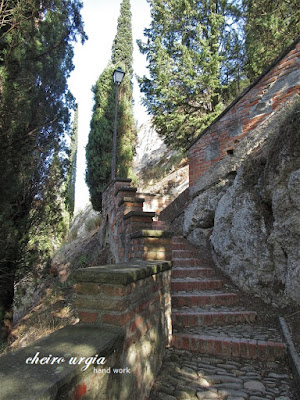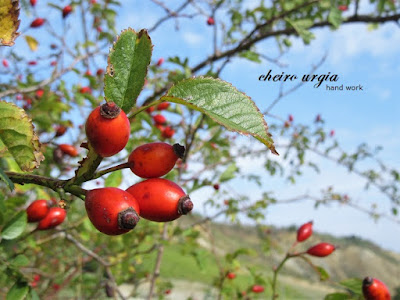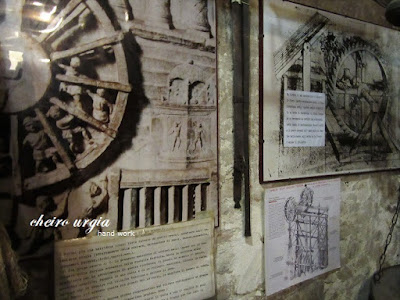To be precise, we'd start our sightseeing at the rural church of San Giovanni in Ottavo just outside of the village itself.
It seemed quite abandoned on a lazy autumn morning, but its medieval walls hide an interesting array of paintings, sculptures, and pillars.
In its cellar, though, archaeological are on display, as well as a casting furnace, whose heat was used in the church's floor heating. Who would have thought! The extensive vineyards and olive tree plantations around the village suggest that the region is rich in wine and olive oil. That is, not any olive oil but certainly the best I've ever tasted. Apart from that, the local farmers offer numerous products in the cooperative shop that is located by the main road, and I could absolutely kick myself for not purchasing more of the oil once the little bottle I bought has run out.
Apart from culinary treasures, however, Brisighella will take your heart with its narrow streets, colourful houses, and architectural attractions. The village is marked by three hills, on which people have placed a castle, a church, and a bell tower.
In the settlement itself, the most famous sight certainly is the "Donkeys' Road", a unique indoor street that is located one level up the lovely square and virtually invisible from the outside. Centuries ago it served as part of the fortification system, however, it is nowadays used as a regular - and yet one of a kind - hallway.
And although the donkeys are long gone, people do still live inside the ancient walls while the former stables are being used as cafes, shops, and storage space. Not pictured: Axel - the most adorable dog living behind one of the ground floor doors, who, after a sign of approval, would not stop climbing my lap and licking me all over.
Although Brisighella is really tiny, it is a true paradise for hikers, and in an attempt to get the most out of it, I tried to use the individual time for discoveries to catch some views from one of the nearby hilltops. Continuing the stairs past the dinkey road, I would soon find myself above the lovely red-ish roofs of the village.
A little further, past my potential dream house...
... the first sights revealed how beautiful the region truly is: magical shades of green and brown, tiny houses in the valley, and nothing but blue skies as far as the eye could see.
The walk up and down the clock tower hill probabl take sno more than half an hour, depending on how good you are with steep paths and stairs. It will cause your heart rate go up for sure, but the reward is totally worth it. However, once you hear Mr. Best from your group coughing and puffing behind you, you might as well fly up the last set of steps no matter how out of breath you already are, put on your best poker face once you reach the platform and pretend to admire the landscape when he comes around the corner even though your heart is racing.
A man's ego will be crushed, but the look of surprise on his face mixed with your feeling of sweet victory is priceless.
The region itself must be a hiking heaven not unknown to Slovenian tourists - what else would explain an official bilingual info board in the middle of Italy?
Finally, we'd continue towards our next little town on the menu - Santarcangelo di Romagna.
With the houses of the old city center scattered on a hill, the individual time for discoveries would mean lots of opportunities to walk up and down the streets, which were the usual sort of empty due to the siesta.
From the Ganganelli square with its distinct triumphal arch, dedicated to pope Clemens XIV from the local Ganganelli family...
... I would just walk around aimlessly past the colourful houses, many of them decorated with flowers and other greenery.
Hi there!
The city's belltower, which can be seen from far away, is located on a lovely little square atop the hill. Following a little more of the picturesque roads...
... one will soon reach the other side of the hill, which is marked by the massive Malatesta fortress.
A little further, the way leads towards the Capuchin monastery from where you can either continue into the countryside or return to the center of Santarcangelo on a path that will give you open views of the valley below, including the characteristic hill of San Marino in the distance.
And as if the landmarks above ground weren't enough, Santarcangelo is famous for its branched system of tunnels, which were dug into the sandstone and clay, and once connected the city's houses below ground. While many of the grottos are nowadays being used to store goods, some of them are accessible for public upon request.
A trip to the underworld and a thunderstorm later...
... it was time to learn about the craft of rust-print that is being kept alive in the Marchi printing workshop.
A huge ancient mangle from 1633 is used to mill the fabrics ...
... which are later printed with the help of handmade wooden stamps and rust dyes.
And after a sequence of immersing and washing the linen to fix the colours, the cloth can even be washed in a washing machine without fear of colours losing their shine.
Last but not least, Santarcangelo surprised with a button museum, which - as the name suggests - is entirely dedicated to buttons. What seems to be rather odd and even boring at first, turned out to be a uniquely interesting story of buttons from all over the world: buttons made from all kinds of materials that come in different shapes and sizes, old ones, new ones, buttons as far as the eye can see!
Buttons from long-gone military uniforms...
... Czech glass buttons...... buttons made as mosaics...
... buttons from Japan...
... buttons for young and old...
The man who stands behind the unique collection, Giorgio Galavotti, turned out to be the kindest and sweetest host, proudly displaying his 8500 pieces of buttons on display. Many of them represent different materials, techniques, and countries...
... while others are unique in the story they represent and things they have witnessed.
And while I've already seen some of them in the most beautiful city of all...... I certainly never wondered about how exactly a button is made.
Once day turned into night and it was time for dinner, what could be better than a quick course in making local pasta at an agrotourism? Maybe taking home a bottle of their wine in a spontaneous competition for the best pasta dough?
Oh and dear lady who thinks something along the lines of "it's not t-h-a-t good at all" will be a consolation for (what you obviously considered) defeat or a successful attempt to diminish my joy: I certainly hope neither worked, the fine grape juice was delicious and we all loved it.
~ to be continued ~
























































































No comments:
Post a Comment